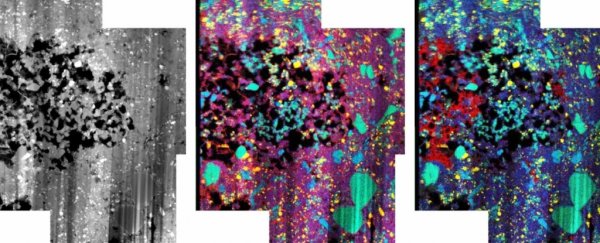A meteorite found in the Algerian desert in 1990 is yielding new clues about the formation of the Solar System. New analysis of meteorite Acfer 094 has revealed tiny pores distributed throughout the rock - ancient fossilised holes where ice crystals once sat.
We don't know when Acfer 094 fell to Earth, but we know how old it is. Previous analyses suggest the ancient rock fragment is around 4.6 billion years old - roughly the same age as the Solar System. The new research suggests it came from farther out in the system before making its way to our blue marble.
This means it's like a time capsule - a primitive object left over from the dusty accretion disc that went on to form the planets, and therefore loaded with juicy geological information about our Solar System as it was forming.
As you might expect, Acfer 094 has undergone a fair bit of scrutiny in the three decades since its discovery. But a team of researchers led by planetary scientist Megumi Matsumoto of Kyoto University looked at the space rock in an entirely new way, systematically combining a range of sampling, microscopy, and spectroscopy methods.
In conjunction, these high-resolution techniques revealed a previously unidentified structure to the rock, a highly porous texture widely distributed throughout Acfer 094. It's a bit like a sponge, pocked with tiny pores around 11 micrometers across - just a little bit larger than a red blood cell.
Combined with mineral traces that indicate water interactions took place with the minerals that make up the meteorite, the team concluded that these tiny pores once contained crystals of ice that had long since melted away - just like mould fossils here on Earth, when a creature decays, leaving behind an impression or mould of its body.
There was something puzzling, though. The mineral traces left behind were more abundant than expected for the amount of ice that would have once filled the pores, prompting the team to look for an additional source of these minerals.
To do this, they modelled a reconstruction of the meteorite's parent body - thought to be a planetesimal, or the 'seed' of a planet. Determining how and where it formed allowed for a story on where the object's ice came from, and how it came to disappear.
According to their model, the planetesimal formed in the outer Solar System from "fluffy" dust. In the core, this consisted of silicate grains coated with water ice. As the asteroid grew, it started to accumulate fluffy dust without ice, resulting in an ice-rich core and an ice-poor mantle.
Then, it approached the snow line - the region of the Solar System where ice starts to sublimate from the warmth of the Sun. Here, the ice coating silica grains sublimates, then recondenses into solid rocks of dust embedded in ice. The approaching asteroid would have also accumulated these ice-bearing ultraporous rocks.
Then, when the asteroid crossed the snow line, the ice would have sublimated away, particularly in the core. This would have altered the structure of the asteroid, leaving behind the empty pores and mineral traces of water interactions.
After this point, the asteroid somehow broke apart, and the Acfer 094 fragment ended up in the Algerian desert.
Evidence of water ice has been found in meteorites before, but how it got there was a mystery. This research now offers a solution to that mystery.
"We here present a new model where the Acfer 094 parent body, ostensibly a planetesimal, formed by icy dust agglomeration in the early Solar System," the researchers wrote in their paper.
"The present scenario is a practical model to give new insight into asteroid formation by combining both analytical results of extraterrestrial materials and theoretical models of planetesimal formation."
The research has been published in Science Advances.
